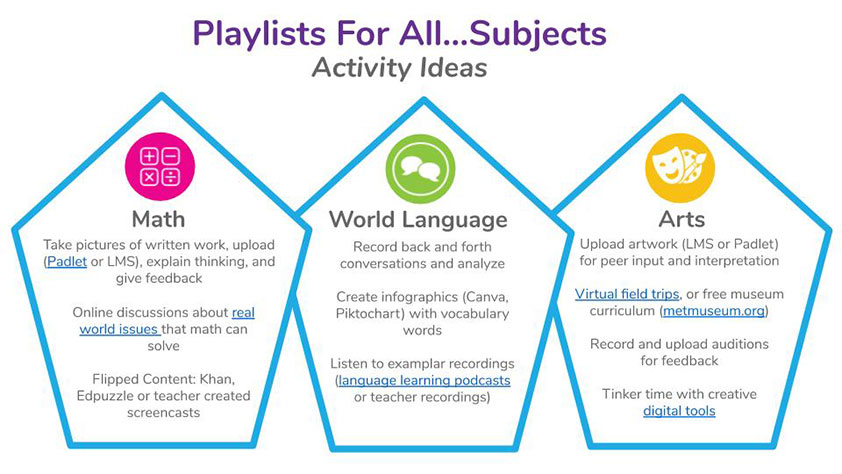Meeting the Needs of All Students Through Playlists
And so it began...technology entered my classroom when two old computers from the newly refurbished computer lab were bestowed upon me as a “gift” to make my classroom more innovative. As most teachers did in 2000, I sighed and thought, “They probably don’t even work.” Little did I know that the adaptive reading software installed on those dinosaurs would be my foray into playlists, which did help me design more innovative learning for my students.
Playlists are vast and varied in their format but their intent is universal—to personalize learning to efficiently and effectively meet student needs. They create asynchronous learning paths that allow students to access content, practice skills, and demonstrate their learning while exercising control over the path, pace, place, and time of learning. The most effective implementation of playlists happens when a variety of formative assessments are embedded to inform the learning process.
As educators move away from the traditional, one size fits all approach to covering content, playlists are an accessible, friendly way to start making this shift. In my experience as a LINC Transformation Agent, I am often asked, “How does a playlist work for…?” finished with either a grade level or subject area. I love this question because the answer is, “Playlists work for all learning environments.” Here I’ll share several common questions that come up in my coaching sessions around how to implement instruction with playlists across the K-12 classroom environments to help you envision how playlists can work for your classes.

Early Elementary
Let’s start right at the beginning: playlists in Kindergarten! First, keep in mind that playlists can and should offer a combination of offline and online activities, so don’t let the pressure to use tech drive the instructional decisions. At any level, I like to ask myself what are some curriculum challenges I encounter and can tech solve the problem? If not, don’t use it. These are the foundational years when key learning habits are formed. Prioritize building independence and self-regulation in your students through the use of playlists. Here are some suggestions for using playlists in younger grades:
- Use QR codes instead of logins.
- Scaffold choices and use a gradual release model.
- Model and rehearse routines for independence.
- Use images/recorded directions for activities in addition to text: A good example comes from Ferry Farm Elementary School: Early Elementary Playlist.
- Reserve time for self and group reflection to build their metacognitive awareness.
- Include higher order tasks, so students learn to think strategically and make real world connections. This could be a great place to build in collaboration too.
Late Elementary/Middle School
The LINC PAACC Framework defines personalization as, “co-creating unique learning pathways and experiences for individual learners.” During late elementary and middle school, students are at the ages where co-creating can become a regular part of instruction and playlists are easily adapted to meet students’ different needs. Pre-conferences with the teacher to identify key standards and plan the path through playlists will increase student engagement and ownership.
This age group benefits from a variety of digital playlist formats. Simple Hyper Docs are a great entry point and allow work to continue outside the classroom for homework or when a student is absent. You can progress to a Google Slide Playlist which offers more student agency. While playlists are designed to increase access and agency, it is important to include accommodations for students who do not have access to technology outside of school. Below are ideas to enhance late elementary and middle school playlists:
- Collaborate beyond the classroom with these tools: Flipgrid, PenPal Schools, etc.
- Provide multiple ways, online and offline, to demonstrate mastery with these tools: Powtoons, Canva, etc.
- Offer standards-aligned playlists with higher order tasks such as Yelena Melnichenko’s Middle School Math Playlist.
High School
This is the launching pad for adult life. The Future of Jobs Report 2018 by the World Economic Forum emphasizes, “A mindset of agile learning will be needed on the part of workers as they shift from the routines and limits of today’s jobs to new, previously unimagined futures.” Playlists at this level should expose students to meaningful, higher order tasks that are relevant to their futures in the workforce. By the time students reach high school, their academic levels range vastly and personalization becomes imperative. Incorporating playlists that cover entire units will help students work at their own pace and get the support they need through small group or 1:1 pullout sessions. This video from Eastern Senior High School in Washington D.C. shows how personalized learning can look in your classroom. Try some of the ideas below with your high school students:
- Offer student-led conferences and check-ins with teacher: LINC Student Conference Form.
- Authentic audience - Not only the teacher (for grades). Include family, community, and peers.
- Unit Playlists: Catlin Tucker’s Argument Writing Playlist.
- Incorporate real-world tasks that are project based and PAACC aligned.
Once your students have built their independence muscles, explore using playlists in other instructional models such as Whole Group Rotation and Station Rotation. I’d love to hear how these strategies are working for you, or if you have others to share. You can find me on Twitter @mskimbaweb